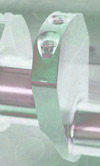Crankshafts: Stress-concentration mitigation
 In previous articles on the subject of crankshafts, we have touched on the benefits of compressive residual stresses. Two methods by which this might be introduced have been discussed, these being nitride hardening (nitriding) and fillet rolling, although there are many others, some of which will be discussed at a later date. By imparting these residual stresses to the surface of the material, there is a large increase in fatigue strength, which gives a greater factor of safety against failure by fatigue.
In previous articles on the subject of crankshafts, we have touched on the benefits of compressive residual stresses. Two methods by which this might be introduced have been discussed, these being nitride hardening (nitriding) and fillet rolling, although there are many others, some of which will be discussed at a later date. By imparting these residual stresses to the surface of the material, there is a large increase in fatigue strength, which gives a greater factor of safety against failure by fatigue.
Once this strategy of introducing compressive residual stress has been employed, if you still experience crankshaft failure, the path that you might reasonably follow is to provide more material, or more generous fillet radii. However, design changes in this direction are generally quite limited owing to space restrictions and the geometry of other components and this is especially true of highly optimised racing engines, which we design to be small, light and compact where possible.
Something that we can do to improve the situation is to remove material from areas of the crankshaft by means of machining operations. Probably the best-known works on the subject are the 1943 Sulzer Technical Review paper by Martinaglia written in English and the paper in German by Lurenbaum, both of which are referenced in volume 2 of "The Internal Combustion Engine in Theory and Practice" by C.F. Taylor. These papers detail changes made to the design of a crankshaft by removal or redistribution of material from the main bearing shafts, the crankpins and the webs and the results of torsional fatigue strength tests on the components. Today we would be able to use finite element methods to good advantage to get the results using a fraction of the time and money. Some of the material removal details that they describe lend themselves to large cast crankshafts, particularly where crankpins and main bearings are made hollow with undercut bores. These design features would be really tricky and probably impossible to implement in many of today's racing engines which rely on the structural durability afforded by machining from a high quality billet of steel. The results of the tests are certainly very impressive, with an improvement in torsional fatigue strength of over 200% compared to the basic 'reference' design. For those familiar with adding more material and therefore more weight to increase fatigue strength, the concept of material removal to achieve the same end might not seem intuitive. However, it is a proven technique as demonstrated by the results of the experiments referred to above, and the general method of material removal to reduce stress concentration factors is well known and well documented.
I have been lucky enough to see a machined crankshaft destined for a Grand Prix motor racing engine which has many of the design features described in the references. This clever piece of design work, destined for the famous pre-war Mercedes Benz SSK (car shown in picture) originated on a drawing board in Europe several decades ago, before the idea of every design engineer having a 3D CAD system and his own personal computer had been thought of.
Fig. 1 - 1930 Mercedes-Benz SSK Roadster.
Written by Wayne Ward